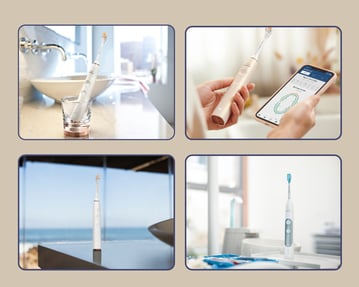How Philips Oral Healthcare is Addressing Periodontitis
Philips Oral Heathcare is on a mission to improve 2.5 billion lives a year by 2030 by looking beyond gingivitis and taking on periodontitis. To that end, the company will continue to innovate oral hygiene technologies and support dental professionals’ efforts to educate and motivate their patients.
This ebook includes data from numerous studies, including an 11-year longitudinal study that followed patients’ oral homecare. The results showed that using a power toothbrush resulted in “significantly less progression of probing depth, attachment level, and decayed, missing, and filled surfaces” than using a manual toothbrush. The participants using a power toothbrush also lost fewer teeth than manual toothbrush users.1

A 2020 study was designed to address the apparent gap in periodontitis patients being given adequate home care tools and strategies, with results published in 2024. The effects of powered and manual toothbrushing on bleeding on probing (BOP) and other clinical signs of periodontitis in patients who had received scaling and root planing (SRP) were compared.2 Participants were evaluated every 4 weeks for: BOP, surface biofilm (MPI), probing pocket depth (PPD), and clinical attachment level (CAL) until week 24.2
It was found that when SRP is combined with daily use of a powered toothbrush, the clinical symptoms of periodontitis and surface biofilm levels were significantly reduced compared to a manual toothbrush, and the effects of SRP were maintained for the study period. The outcomes of the study indicate that using a power toothbrush after receiving SRP may result in the periodontium remaining stable.2

A partnership between academic research, dental practitioners, and healthcare industry is critical to ensuring patient health, long-term. — Purnima Kumar, BDS, MS PhD, Professor of Periodontics
Halting the progression of periodontal disease requires constant collaboration between dental professionals and their patients. Achieving oral health relies on a combination of receiving professional dental treatments and using the appropriate home care tools as well as patient support, education, and behavior modification.
Purnima Kumar, BDS, MS, PhD, Professor of Periodontics at the University of Michigan School of Dentistry, has been working with Philips Sonicare for many years. She considers her patients to be her partners. “I’m trusting completely that patient is my partner in this program,” she continues. “We are here to treat the disease, but to maintain themselves and their health is the patients’ role. We do cutting-edge research; we transmit it to our patients and truly this puts that control back in the patient’s hands. So, you the patient are the creator of your health and here are some tools by which you can do this well.”

We have lots of studies that show our devices improve oral health, but we wanted to take it one step further. Most periodontal treatment studies are what can happen in the chair. This study was really confined to what can a patient do at home. — Michelle Starke, PhD, Sr. Clinical Scientist, Philips
Jonathan Vo, DMD, MSE, totally agrees. “It becomes a partnership between me as a provider and them as a patient,” he says, “and to really understand what their wants and needs are and what their goals are in terms of health and esthetics.”
It is inspiring for dental professionals to see that they have had an impact on a patient’s oral health. “It’s those ‘aha’ moments when people come back and are genuinely really excited to share that they implemented a change and that they’re seeing the results from that change,” says Amy Mortensen, RDH. “That knowledge gives them power to understand why it is important to do what is recommended.”
Click here to download the Philips Sonicare ebook and learn more.

We’re not simply curing or treating disease. We are empowering the patient. We’re putting the patient back in the driver’s seat of their own health. -- Purnima Kumar, BDS, MS PhD, Professor of Periodontics
References
- Pitchika V, Pink C, Völzke H, et al. Long-term impact of powered toothbrush on oral health: 11-year cohort study. J Clin Periodontol. 2019; 46(7): 713-722. doi:10.1111/jcpe.13126.
- Jenkins W, Starke EM, Nelson M, Milleman K, Milleman J, Ward M. The effects of scaling and root planing plus home oral hygiene maintenance in Stage I/II periodontitis population: A 24-week randomized clinical trial. Int J Dent Hygiene. 2024;00:1-9. doi:10.1111/idh.12783.